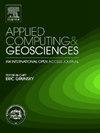Advanced AI techniques for landslide susceptibility mapping and spatial prediction: A case study in Medellín, Colombia
IF 3.2
Q2 COMPUTER SCIENCE, INTERDISCIPLINARY APPLICATIONS
引用次数: 0
Abstract
Landslides, a global phenomenon, significantly impact economies and societies, especially in densely populated areas. Effective mitigation requires awareness of landslide risks, yet temporal links between occurrences are often neglected, challenging model performance due to non-stationary triggering and predisposing factors. This study presents a novel landslide susceptibility model that incorporates spatial and temporal dependencies, including landslide recurrence. We applied AI models — Naive Bayes, Linear Discriminant Analysis, Quadratic Discriminant Analysis, Decision Trees, Random Forest, and Support Vector Machine (SVM) — to a case study in Medellín, a mountainous city in northwest Colombia. Using heuristic methods, we evaluated geological and geomorphological characteristics to identify high-risk areas. Integrating temporal data from four consecutive periods allowed us to enhance estimation robustness by incorporating random effects. Our findings identify slope, stream distance, geology, geomorphology, and mean annual precipitation as key factors influencing landslide susceptibility in Medellín. The SVM model demonstrated superior performance with an accuracy of 85%, closely aligning with previous studies. This research underscores the importance of temporal dynamics in landslide susceptibility assessments, improving prediction accuracy and supporting more effective risk management.
用于滑坡易感性测绘和空间预测的先进人工智能技术:以哥伦比亚Medellín为例
山体滑坡是一种全球性现象,对经济和社会产生重大影响,特别是在人口稠密地区。有效的缓解措施需要对滑坡风险的认识,但灾害发生之间的时间联系往往被忽视,由于非平稳的触发和诱发因素,这对模型性能构成了挑战。本文提出了一种新的滑坡敏感性模型,该模型考虑了包括滑坡复发在内的时空依赖关系。我们将人工智能模型-朴素贝叶斯,线性判别分析,二次判别分析,决策树,随机森林和支持向量机(SVM) -应用于哥伦比亚西北部山区城市Medellín的案例研究。利用启发式方法,我们评估了地质和地貌特征,以确定高风险地区。整合来自四个连续时期的时间数据使我们能够通过纳入随机效应来增强估计的稳健性。研究结果表明,坡度、河流距离、地质、地貌和年平均降水量是影响Medellín滑坡易感性的关键因素。支持向量机模型表现出优异的性能,准确率达到85%,与前人的研究结果非常接近。这项研究强调了时间动态在滑坡易感性评估中的重要性,提高了预测精度,支持了更有效的风险管理。
本文章由计算机程序翻译,如有差异,请以英文原文为准。
求助全文
约1分钟内获得全文
求助全文
来源期刊

Applied Computing and Geosciences
Computer Science-General Computer Science
CiteScore
5.50
自引率
0.00%
发文量
23
审稿时长
5 weeks
 求助内容:
求助内容: 应助结果提醒方式:
应助结果提醒方式:


